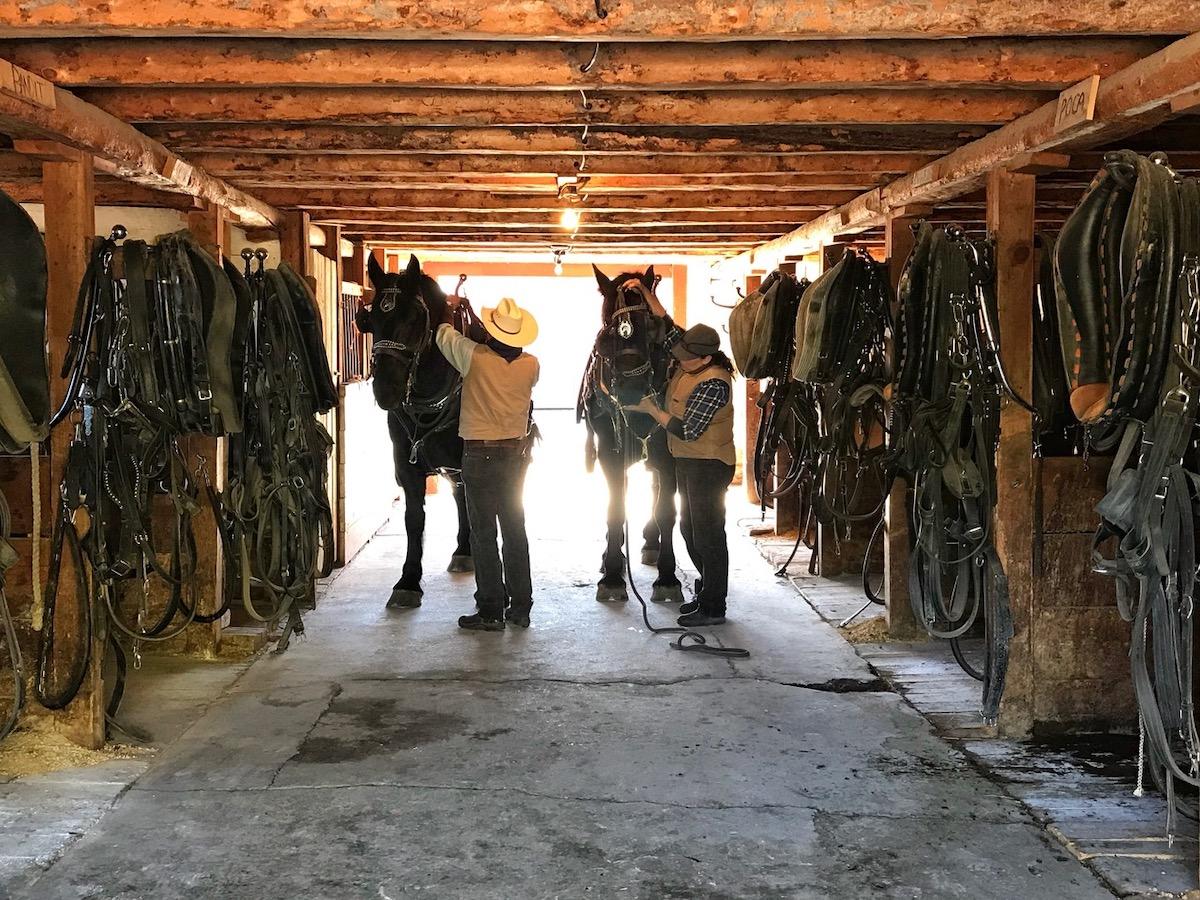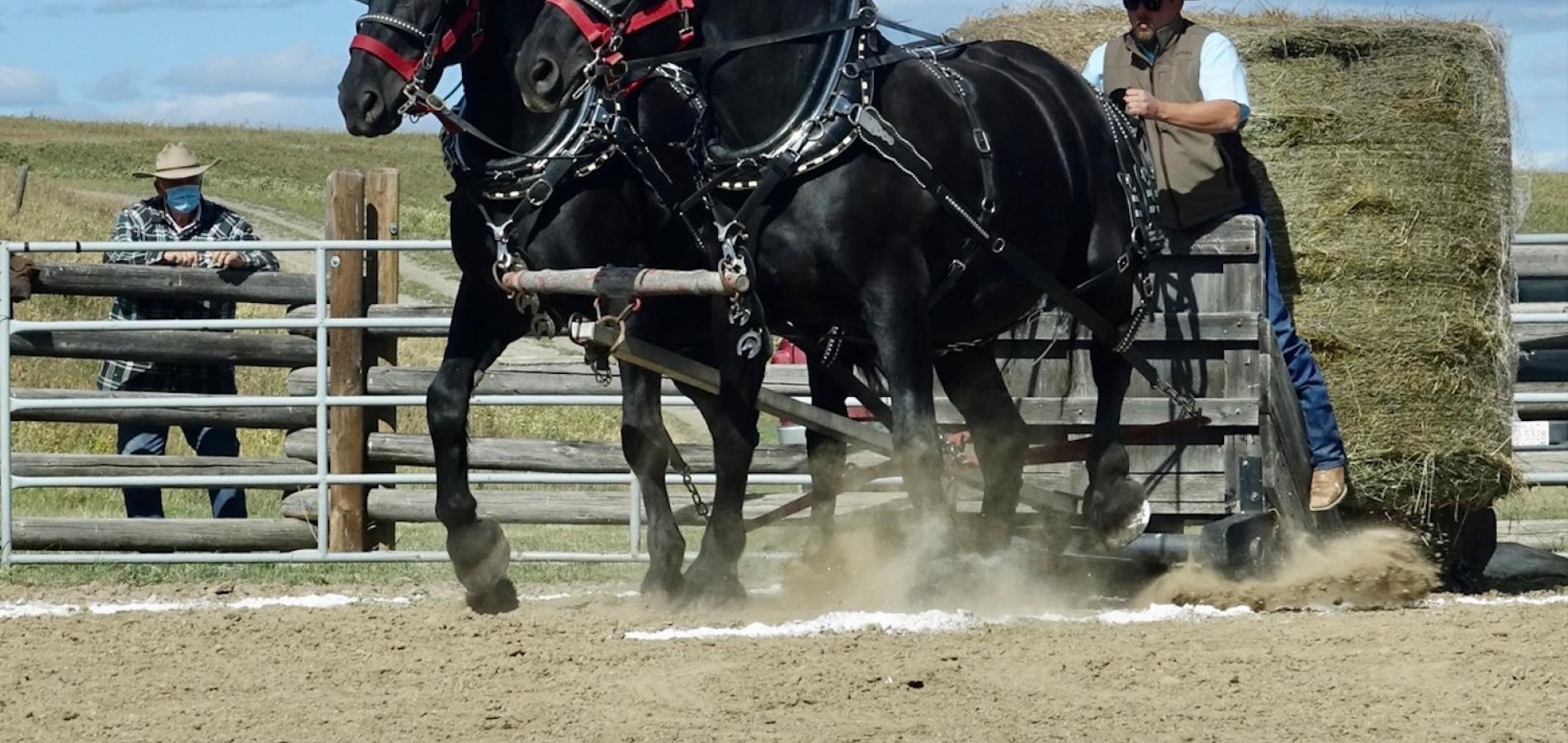Less than an hour’s drive southwest of Calgary, Bar U Ranch National Historic Site — the only one administered by Parks Canada to celebrate ranching history — recently received infrastructure funding to preserve key buildings. The investment ensures visitors can have authentic experiences for years to come at a site with the country’s largest collection of historical ranch buildings.
Bar U is located on part of what was once one of the first corporate ranches to shape western Canadian landscapes in the 1880s. Before settlers arrived in Alberta, the Government of Canada under Prime Minister Sir John A. Macdonald offered ranchers 21-year leases for a penny per acre to a maximum of 100,000 acres, hoping to spur development and assert sovereignty over what was an isolated region of the new country.
Entrepreneurs saw an opportunity to raise cattle on prairie cleared of bison and snapped up vast swathes of land. Quebec stockman Fredrick S. Stimson and Montreal’s wealthy Allan Family created the North West Cattle Co. and gained two leases for 147,000 acres. They founded the Bar U in 1882 adding 3,000 Durham-Shorthorn stocker cattle, 21 purebred Shorthorn bulls and 75 saddle horses. Stimson became the resident manager.
George Lane arrived in 1884, becoming foreman of the North West Cattle. A skilled horseman and very ambitious, in 1902 he was able to buy the Bar U, eventually becoming one of the wealthiest men in Alberta and one of the four fellows who bankrolled the first Calgary Stampede.

Bar U celebrates ranching history/Carol Patterson
Lane created a world-renowned stable of Percheron horses at the Bar U between 1902 and 1925. The large black horses were popular work animals and Lane anticipated that the settlers to come would need the equines for farm chores.
He imported three purebred Percheron studs (stallions) and 72 mares from France, the country where the breed originated, and grew his stock until he had the largest purebred Percheron herd in the world. His reputation grew, too. At the World’s Fair in 1909, Bar U Percherons won almost every event they entered.
Lane also befriended a future king. In 1919 when Edward VIII, Prince of Wales, toured the Bar U (before he became king), he was so enthralled with the cowboy lifestyle he purchased the neighboring ranch and renamed it the E.P. Ranch. Although he would only visit the ranch a few times during his life, Edward took an interest in ranching and imported livestock to Alberta from his breeding farms in England.
The fortunes of the Bar U ebbed and flowed with world events and droughts. During the Second World War, Lane’s successor, Pat Burns, drew on historical connections to Stoney people to staff the ranch when many riders enlisted. Cattle remained important to the Bar U under Burns but as trucks and tractors replaced horse teams, the Percheron barns were converted to grain storage and surplus horses sold.
By 1950, a major part of the ranch and remaining horses and cows were sold to Allen Baker, who owned the ranch longer than any of his predecessors. But by 1975, the ranch headquarters and some of the land was sold to the Wambeke family, who in turn sold it to Melvin Nelson in 1984.

Most Bar U Ranch buildings are in their original locations/Carol Patterson
At the time Parks Canada was looking for a site suitable for commemorating the country’s ranching history. The Bar U as one of Canada's most famous ranches in Canada, and at one time one of its largest at 157,960 acres (63,184 hectares), was a logical candidate. Parks Canada was interested in the large collection of historic buildings.
Negotiations began, and in 1991 Parks Canada purchased the original ranch headquarters and 367 acres (148 hectares) from Melvin Nelson. On July 30, 1995 the Bar U Ranch National Historic Site officially opened.
In 2017, Parks Canada announced a $3-billion (Canadian) investment program to rehabilitate infrastructure across its asset base including $4 million to refurbish and preserve four high-visitor-use buildings — the Implement Shed, Slaughter House, Studhorse Barn and Workhorse Barn. The goal was to make infrastructure safer, support conservation and promote more appealing visitor experiences.

The Bar U logo is painted on the roof of Workhorse Barn/Parks Canada Agency
The Studhorse Barn and Workhorse Barn are both critical to the story of horses and Bar U history. The Studhorse Barn was built around 1910 and housed Lane’s impressive line of Percheron stallions. Site manager Dylan Spencer says the exact number of stallions kept here is unknown but it was “probably 20 to 30 horses.” Stallions are high energy and often aggressive and would have been kept separate from mares and geldings.
The Workhorse Barn would have sheltered heavy and saddle horses, and even today it houses about a dozen ranch horses. The number fluctuates from year to year, but there are currently seven Percherons, used for wagon rides, and several saddle horses.
Restoration for the Studhorse barn included improvements to the north wall and minor repairs to the buildings walls and covering. “The work on that building isn’t as obvious or visible unless you have an interpreter with you that can point it out,” Spencer explains.

The Studhorse barn after renovations/Parks Canada Agency
Work done on the Workhorse Barn was more extensive. “In spring of 2020 the Workhorse Barn was lifted off its original foundation and this revealed a quite interesting original sandstone foundation. A lot of that original sandstone wasn’t visible because it had sunk into the ground,” Spencer says. ”The sandstone foundation was dismantled and moved off to the side during construction and then it was reincorporated into the new foundation. Windows and doors were also repaired, and the Bar U brand painted on two faces of the roof, and the building was repainted.” The restoration was completed last September.
As these buildings are classified as historical buildings under federal legislation, great care was taken in the restoration. “The Workhorse Barn along with 30 other of our buildings are designated as classified historical buildings, meaning they’re in some ways treated exactly the same as the parliament buildings in Ottawa,” Spencer explains. “Parks Canada is legislated to preserve heritage character of the buildings, in this case, the barn, and that includes its location, its relationship to other buildings and materials." And before any work on the buildings can start, extensive research goes into design and planning and includes heritage architects, engineers, archaeologists, historians, cultural resource experts and local community members.
Construction proceeded relatively smoothly despite the pandemic. While most work was done by outside contractors, some elements were completed by staff. Restoration carpenter Patrick Davis worked on doors and windows and replacing chinking (little wood slats stuck between the logs) and daubing (the mud or moss that was stuffed in between the logs and chinking). Archeologists monitored the work and discovered vintage, hand-forged horseshoes when the original sandstone formation was revealed under the Workhorse Barn.

Bar U Ranch site manager Dylan Spencer/Carol Patterson
Visitors to the Bar U approach from Highway 22 (also known as the Cowboy Trail). Pre-pandemic only 15,000 to 20,000 visitors arrived each year, a far cry from the millions visiting Banff National Park, a similar-length drive from Calgary in a different direction. The ranch is only open from May to September.
A modern visitor center sits atop a bluff overlooking the old ranch buildings. A gravel road leads down to the western settlement nestled against a backdrop of Rocky Mountains and foothills. Volunteers greet visitors as they meander down the main street past the post office, cookhouse or other historical buildings.
Peeking in an open door or admiring a horse will often elicit conversation with one of the Parks Canada staff or a volunteer from the Friends of the Bar U Historic Ranch Association, and the chance to hear stories from people who live in the area.
“We focus on what we do best, sharing and celebrating the story of ranching, and that can include hands-on activities like roping, feeding the pigs, learning about famous Western painter Charlie Russell and then taking a brush in your hand and making your own little painting on a piece of barn board,” says Spencer.

Bar U visitors experience Percheron-led wagon rides/Carol Patterson
Wranglers may be tacking up a team of big, black Percherons for popular wagon rides that recreate old-fashioned transport. A pot of coffee may be boiling over a wood fire near Pekisko Creek and a recreated Round-up Camp. Tucked in the trees is a white tipi at the Stoney Nakoda Camp with interpreters offering an Indigenous perspective on historical stories and reminders that the ranch lies within traditional Indigenous territory.
A main focus of the restoration was preserving the built structures that are the backdrop for visitor experiences. “It ensures that they’ll be enjoyed for years to come," says Spencer. "The Workhorse Barn itself is about 130 years old and with the extensive work that it’s had, should last for quite a while longer, and be enjoyed as a working barn and as a testament to that history for a long time. There is an aspect of historical realism that we hope to preserve in the structures. The majority of our buildings sit in the exact location where they were built. And the visitor experiences the ranch not only as it was, more or less, a hundred and some years ago, but also has an authentic experience of how the structures were used at their time for their particular purpose.”
Although the location of the buildings may not attract attention, preserving the historical footprint offers educational opportunities as visitors get a sense of how far cowboys would have walked each day between chores and meals, or how horses would have been shifted between barns, corrals and the blacksmith.

Putting tack on horses in the Workhorse Barn/Carol Patterson
As well, some of the artifacts discovered during the restoration — such as the forged horseshoes in the Workhorse Barn foundation — have been added to the interpretative collection.
The Bar U has added special events to its educational programming to attract visitors and highlight ranching culture and history. “Special events draw bigger crowds," says Spencer. "The story of ranching gets out to a larger audience. There are usually ample opportunities for them to explore the site while they are here. Many people describe it as, ‘I came for the event but I learned a lot about the history of ranching and the importance of the Bar U in that.'"

Competitors put a modern spin on cowboy skills at Bar U's extreme cowboy races/Carol Patterson
Previous events have included skills demonstrations like the Chore Horse Competition where teamsters drive a pair of heavy horses through obstacles replicating tasks done by horses before tractors. Other events blend historic and contemporary takes on horsemanship. Extreme Cowboy Racing challenges saddle horse riders to replicate cowboy skills but they may be roping a stuffed bear instead of a cow, and many of the competitors are female. Special events are subject to health restrictions but plans for this year include a roster of activities similar to 2021.
And people, regardless of the reason for their visit, will discover that while restorations have improved key buildings, ranch hospitality still has the same western warmth felt a century ago.



 Support Essential Coverage of Essential Places
Support Essential Coverage of Essential Places







Add comment